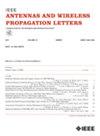一种新的低秩压缩方案的定向分组多阶格林函数插值方法
IF 4.8
2区 计算机科学
Q2 ENGINEERING, ELECTRICAL & ELECTRONIC
引用次数: 0
摘要
在这篇文章中,我们提出了一种新的低秩压缩方案来实现定向分组多电平格林函数插值法(DGMLGFIM),这是一种快速的电磁散射求解器。在该方案中,通过方向分组构造DGMLGFIM的树结构,使方向${d}$的格林函数(GF)矩阵的秩为常数。随后,在树的每一层,设计了一个低成本的方法来获得一个公共的酉矩阵Q,该矩阵被一个方向交互列表中的群共享。公共Q可以构造插值系数矩阵G和插值基矩阵W、C,其维数从插值点个数(NIP)压缩到GF矩阵的秩。因此,在DGMLGFIM中,上通、平移和下通操作的计算成本与常数秩有关,而不是与NIP有关。因此,DGMLGFIM的时间复杂度和内存复杂度分别为${O}({{N \log\ N}})$和${O}({N})$,在解决电子大问题时,其中${N}$是未知量。给出了直径为128波长的球体和尺寸为50波长× 50波长的平方贴片阵列散射的数值结果,验证了该方法的有效性和准确性。本文章由计算机程序翻译,如有差异,请以英文原文为准。
A Directionally Grouping Multilevel Green’s Function Interpolation Method With a Novel Low-Rank Compression Scheme
In this letter, we propose a novel low-rank compression scheme for implementing the Directionally Grouping Multilevel Green’s Function Interpolation Method (DGMLGFIM), a fast electromagnetic scattering solver. In this scheme, a directional grouping is performed to construct the tree structure of the DGMLGFIM so that the rank of Green’s function (GF) matrix of a direction ${d}$ is constant. Subsequently, at each level of the tree, a low-cost procedure is devised to obtain a common unitary matrix Q, which is shared by groups in one directional interaction list. The common Q enables the constructions of interpolation coefficient matrix G and interpolation basis matrices W, C with their dimensions being compressed from the number of interpolation points (NIP) to the rank of GF matrix. Consequently, in the DGMLGFIM, the computational cost of the upper pass, translation and down pass operations is related to the constant rank instead of the NIP. As a result, the time and memory complexities of DGMLGFIM scale as ${O}( {{N \log\ N}} )$ and ${O}( {N} )$ , respectively, in solving electrically large problems where ${N}$ is the number of unknowns. Numerical results of the scatterings from a sphere of diameter 128-wavelength and a squared patch array of size 50-wavelength by 50-wavelength are presented to demonstrate its efficiency and accuracy.
求助全文
通过发布文献求助,成功后即可免费获取论文全文。
去求助
来源期刊
CiteScore
8.00
自引率
9.50%
发文量
529
审稿时长
1.0 months
期刊介绍:
IEEE Antennas and Wireless Propagation Letters (AWP Letters) is devoted to the rapid electronic publication of short manuscripts in the technical areas of Antennas and Wireless Propagation. These are areas of competence for the IEEE Antennas and Propagation Society (AP-S). AWPL aims to be one of the "fastest" journals among IEEE publications. This means that for papers that are eventually accepted, it is intended that an author may expect his or her paper to appear in IEEE Xplore, on average, around two months after submission.

 求助内容:
求助内容: 应助结果提醒方式:
应助结果提醒方式:


